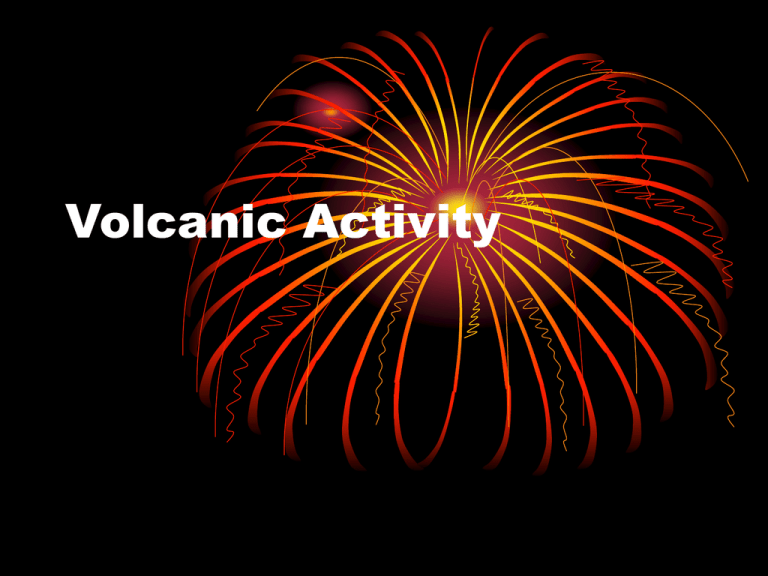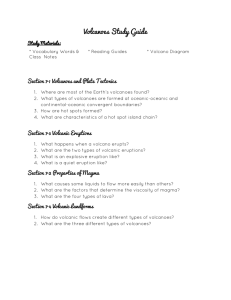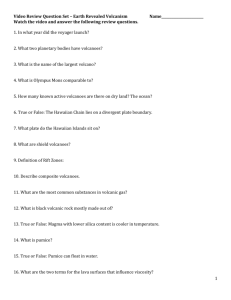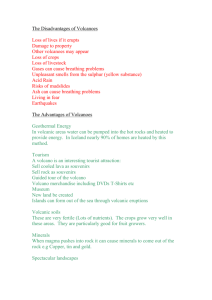Volcanic Activity - Moyle Park College
advertisement

Volcanic Activity Volcanoes • In the last section we learned that the outer layer of the earth is called the Crust. • We also learned that the crust is broken into many different pieces called Plates. • The plates are constantly moving because of Continental Drift. • This movement causes the plates to push together, pull apart, or slide past one another. How do Volcanoes Occur? • Volcanoes occur when two of the earth’s plates pull apart. • Remember, beneath the crust the mantle is made from semi-molten (melted) rocks called magma. • So when a gap occurs in the crust (which happens when two plates pull apart) the magma spills out through the gap. Lava • When the magma reaches the surface of the earth it is called lava. This is the reddish liquid you see coming out of a volcano. The effects of Volcanoes • When the lava comes out of a volcano it cools and forms into solid rock. This can result in the formation of, 1. Mid Ocean Ridges 2. Volcanic Islands 3. Volcanic Mountains Mid-Ocean Ridge • Sometimes volcanoes occur under the sea. • If two plates pull apart under the sea the lava rises up to the ocean floor. • It cools quickly into solid rock as it touches the cold sea water. • After many eruptions these layers of new rock build up to form mountains under the water. • A long chain of volcanic mountains under the sea is called a Mid-Ocean Ridge. The Mid-Atlantic Ridge • Under the Atlantic Ocean the American plate is pulling apart from the Eurasian and African Plate. • This is causing underwater volcanic eruptions which has created a long chain of underwater mountains. • These mountains make up the Mid-Atlantic Ridge. • Some of the mountains in the chain are so high they stick out of the water and form volcanic islands. The Mid-Atlantic Ridge The Mid-Atlantic Ridge Volcanic Islands Volcanic Islands • When underwater volcanoes continually erupt eventually they may grow big enough to stick out of the water. • They form volcanic islands. Iceland is an example of a volcanic island. Iceland: A Volcanic Island • Iceland is a volcanic island which has been formed as a result of underwater volcanic eruptions. Iceland: A Volcanic Island Volcanic Mountains • When two plates pull apart a gap is created. This gap provides a hole which the magma can escape from the mantle. It is called a Vent. • When the magma cools, along with other materials from the volcano such as mud and ash, they usually form a cone shaped mountain Volcanoes Stages in volcanoes • Volcanoes can be in one of 3 stages, 1. Active 2. Dormant 3. Extinct Stages in volcanoes Active Volcanoes - The volcano is still erupting quite regularly. E.g. Mount Etna, Italy. Dormant Volcanoes - The volcano has not erupted for a long time but may erupt in the future. Extinct Volcanoes – The volcano has not erupted in historic times and will not erupt again. The Pacific Ring of Fire • Many of the world’s major earthquakes and many of the world’s active volcanoes occur in a zone that encircles the Pacific Ocean. • This is because many of the world’s major plates meet here. Therefore, at this place the plates are pulling apart, pushing together and sliding past one another. • This causes earthquakes and volcanoes to occur. The Pacific Ring of Fire The Pacific Ring of Fire






